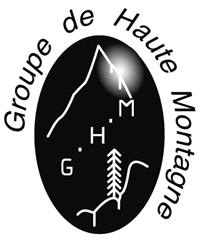The year 2021 marks the 30th anniversary of the inception of the Piolet d'Or, an idea proposed by the late Jean-Claude Marmier and François Marsigny. It resulted in a partnership between the Groupe de Haute Montagne, of which Marmier was president, and Montagnes Magazine under the then editor-in-chief Guy Chaumereuil. Back then the ethos of the award was different than today. There was a single award each year, with an emphasis directed perhaps more towards performance than style. For each year we have described the awarded ascent and listed the nominations - often with the style in which they were achieved. We have then added a non-exhaustive list of other notable ascents, mostly in the Greater Ranges and carried out in alpine-style, which didn't make the nominations. Hopefully, these entries for each year will provide a good résume of the mountaineering history of the time and reveal how the Piolet d'Or has evolved.
- 1992
-
For this inaugural edition of the Piolet d'Or, held at the International Mountain Film Festival in Autrans, France, the jury comprised Jean-Claude Marmier, Bernard Domenech, Andrzej Zawada, Franco Ribetti, Józef Nyka, Jean-luc Amstutz, and Yves Astier. The routes nominated for an award were all climbed the previous year – 1991.
Their award – a "Golden Ice Axe", manufactured by Grivel - went to the first ascent of the south-southwest ridge of Kangchenjunga South.
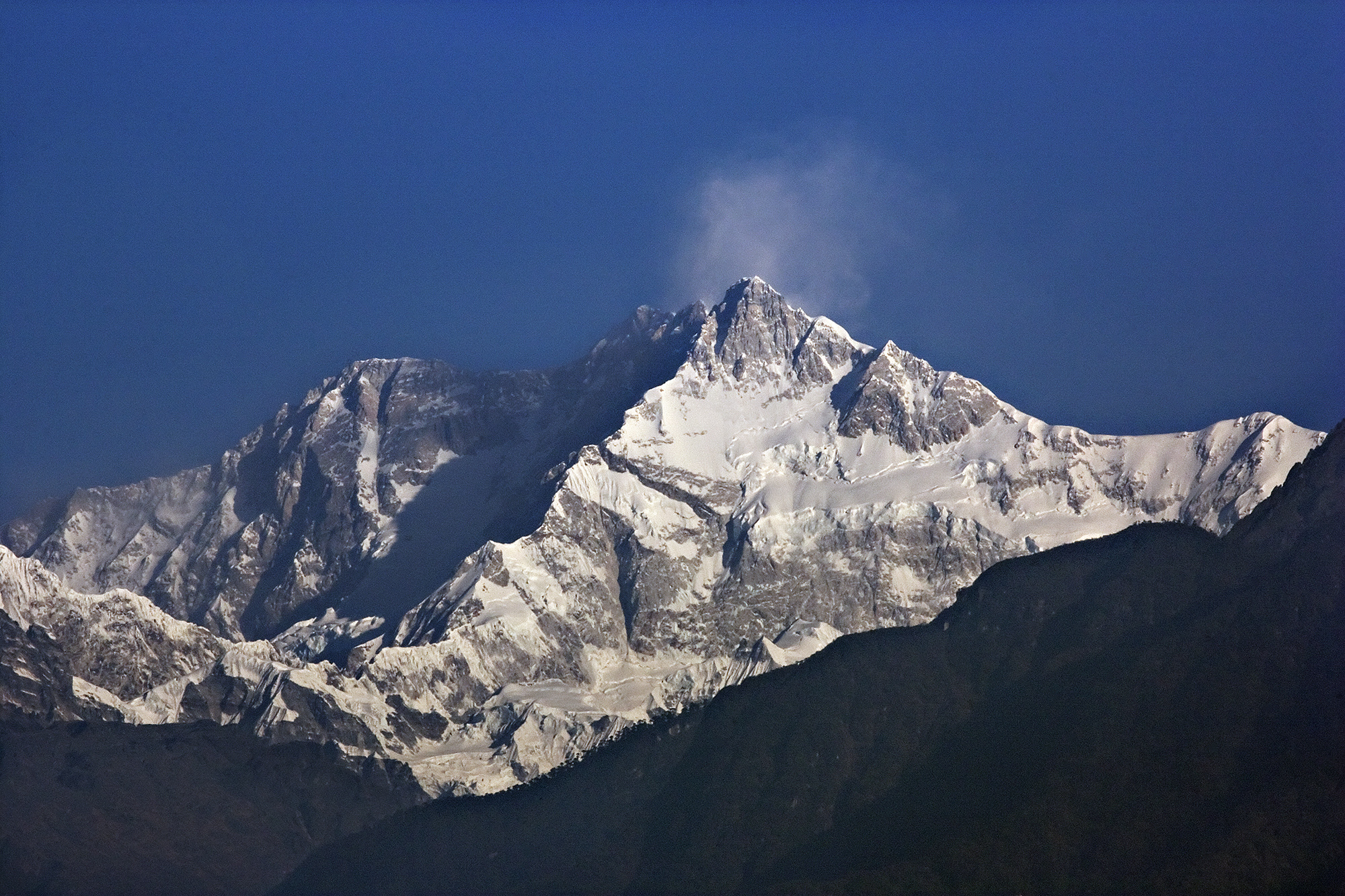 Jakub Michankow, CC BY 2.0 <https://creativecommons.org/
Jakub Michankow, CC BY 2.0 <https://creativecommons.org/licenses/by/2.0>, via Wikimedia Commons
Kangchenjunga from the southeast. The south-southwest ridge is the line between shadow and sunlight, slanting up right to the south summit.Following fast acclimatization ascents of Boktoh and a new route on Talung, Slovenians Marko Prezelj and Andrej Štremfelj spent five days making the first ascent, in pure alpine-style and with no supplementary oxygen, of the almost 3,000m-high south-southwest ridge of Kangchenjunga South Peak (8,476m). The pair overcame difficulties of VI A1 90°in the lower section and battled very strong winds in the upper part of the route. From the summit they descended new ground to reach Camp III at 7,250m on the normal route.
https://aac-publications.s3.amazonaws.com/documents/aaj/1992/PDF/AAJ_1992_34_66_001.pdf
Other ascents nominated that year were:
• Metanoia on the north face of the Eiger by American Jeff Lowe, solo
• A new route on the south face of Mount Dickey in the Central Alaskan Range using fixed ropes by Italians Giuseppe Bagattoli, Paolo Borgonovo, Fabrizio Defrancesco, Bruno de Dona, Fabio Leoni, Mario Manica, and Danny Zampiccoli.
• Manitua on the north face of the Grandes Jorasses by Slovenian Slavko Svetičič, solo.
• A new route on the west face of the Petit Dru by Frenchwoman Catherine Destivelle, solo
• A fast ascent, without supplementary oxygen and with a new variant in the lower section, of the Great Couloir on Everest by Italian Battistino Bonali and Leopold Sulovský from the Czech Republic. Camps previously established by other members of the expedition.
• The routes Un Autre Monde and L'ecume de Jours on Mont Blanc by Frenchman Jean-Christophe Lafaille.
• The northwest face and north ridge of K2 by the French Pierre Beghin and Christophe Profit.
In terms of climbing fast at high altitude with a minimalistic style this last ascent was notable. With few climbers on the mountain due to the Gulf War, Beghin and Profit made at least half a dozen attempts up to 7,000m on the northwest face of K2, approaching from the south and crossing onto the Chinese flank. On their final try they reached and then followed the 1990 Japanese route up the northwest face to finish via the north ridge, then reversed their route in deteriorating weather. Although a committing alpine-style ascent without supplementary oxygen, it climbed little new ground.
Other ascents from 1991
The year 1991 was rich in high standard, alpine-style ascents. Others that were not nominated included:
• The first ascent of the Phantom Wall on Mount Huntington by Jay Smith and Paul Teare, a route not repeated in its entirety until 2013
• The first ascent of the huge Washburn Wall on Denali by Gregory Collins, Phil Powers and Tom Walter, though they didn't continue to the summit
• A big, steep ice route on the north face of Pik Piramidalny in the Karavshin by Paolo Tamagnini, solo
• The first ascent of the north face of Thalay Sagar by the Hungarians Péter Dékány and Attila Ozsváth
• Alpos Secret on the west face of Illampu by Dušan Debelak and Tomaž Žerovnik, considered the hardest ascent in Bolivia at the time
• The southwest buttress and south ridge of Kusum Kanguru West Top by Dick Renshaw and Stephen Venables
• And although he didn't reach the summit of Annapurna, stopping 100m below the top then traversing to and descending the normal route on the north face, Slavko Svetičič's new line on the west face, climbed solo, was equally notable.
- 1993
-
At the 1993 International Mountain Film Festival in Autrans the Piolet d'Or was awarded to the new route, Dans l’œil du cyclone, on the east face of the South Tower of Paine.
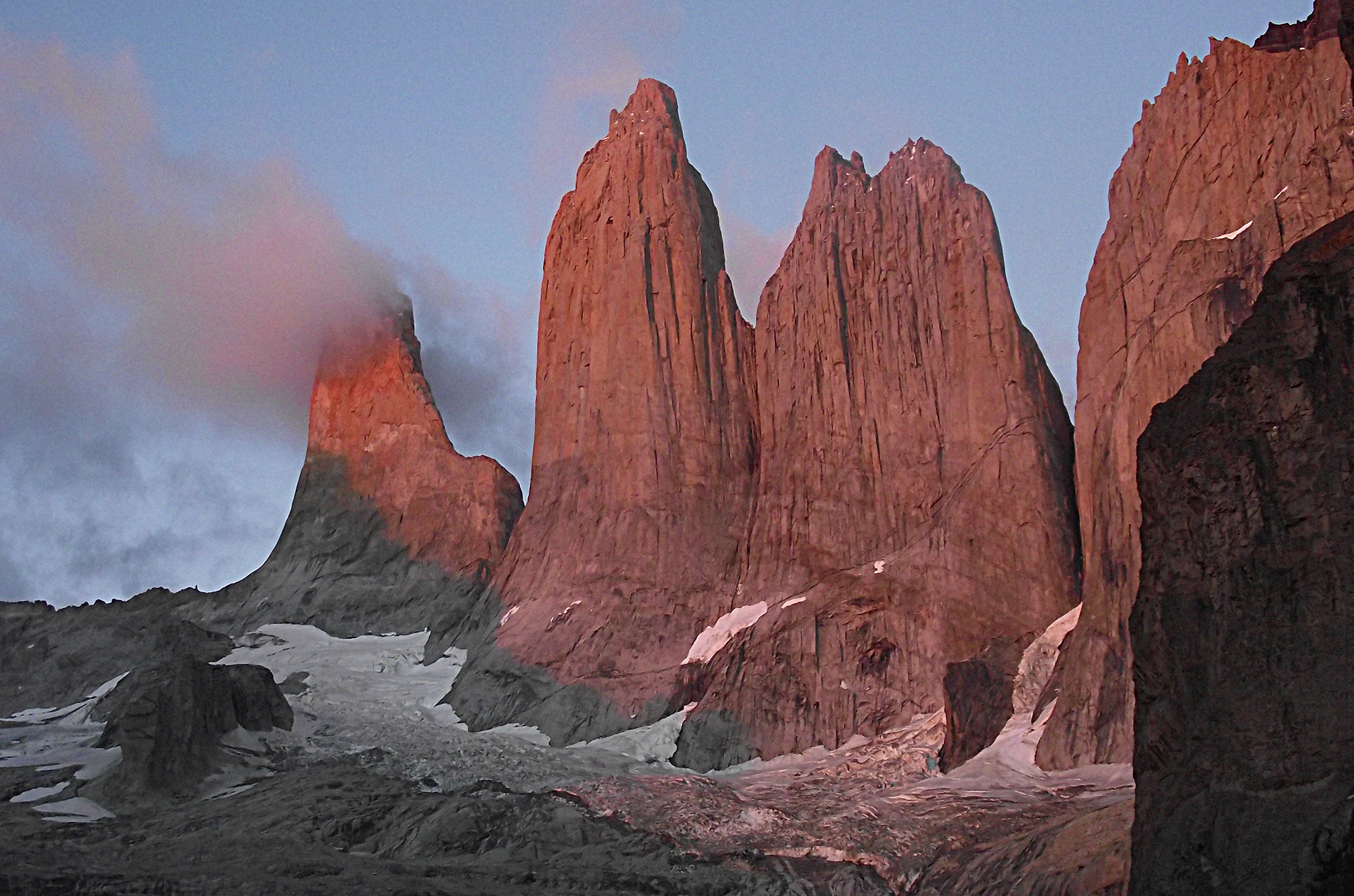
By Christian Jungmann - Own work, CC BY-SA 3.0, https://commons.wikimedia.org/
w/index.php?curid=32332414 The towers of Paine from the northeast. Dans l’œil du Cyclone climbs the centre of the face of the left (south) tower.
After establishing a camp at the foot of the 900m high east face of the South Tower (2,500m), the highest of the three Paine towers, Vincent Sprungli and Michel Piola spent four days fixing rope up the steepest part of the wall, to the right of a line almost climbed in 1985 by an American-South African team. On their fifth day on the face, they jumared to their high point at 500m, then continued in good weather to reach the summit at 8pm. The rock proved compact and the difficulties of Dans Dansl’œil du Cyclone were rated 6b A4, with much hooking and copperheading.
http://publications.americanalpineclub.org/articles/12199318902
Other ascents nominated that year:
• First ascent, in alpine style, of PanchChuli V via the south ridge by Dick Renshaw, Victor Saunders, Stephan Sustad and Stephen Venables. An accident on the descent badly injured Venables, who was evacuated by helicopter.
• The Abruzzi Ridge on K2 climbed in classic style by Chantal Mauduit.
• First ascent of Beyond Good and Evil on the north face of the Aiguille des Pélerins by Andy Parkin and Mark Twight.
• The first female solo ascent of the north face of the Eiger (and in winter) by Catherine Destivelle.
• New route on the east face and northeast face of Broad Peak Central climbed in siege style. Summit reached by Enric Dalmau, ÒscarCadiach, LluísRàfols and Alberto Soncini.
• Ascents of the first ice routes to be graded 7, La Lyre by Thierry Renault and La Massue by François Damilano, opened the same day in Sixt Fer à Cheval.
Other ascents
Other notable first ascents that year included:
• The Grand Voyage (5.10 A4+ WI3) on the east face of Great Trango Tower by Xavier Bongard and John Middendorf - a capsule ascent that at the time was considered perhaps the hardest big wall climb at altitude
• First ascent of Menlungtse by Marko Prezelj and Andrej Štremfelj in alpine style via the southeast face
• El Regalo de Mwoma (5.10 A3+) on the east face of the Central Tower of Paine, where the top was reached by Paul Pritchard and Sean Smith [much of the route was fixed in a similar way to Dans l’œil du Cyclone].
- 1994
-
The 1994 Piolet d'or was again held at Autrans. The award went to various hard new routes and free ascents in the Ak-su Valley of the Karavshin region of Kyrgyzstan, climbed by a primarily young French team.
A young French expedition, selected by the Group de Haute Montagne and led by Remy Karle, Luc Jourjon and François Pallandre, spent a month in the Ak-su Valley of the Karavshin, Pamir Alai, climbed many new routes. Most notable were Butterfly on the west face of Central Pyramid, and Artificial Paradise on the north face of the same peak, the 48-pitch southeast ridge of the Peak of 40 Thieves, and a free ascent of Peristroika Crack on the Russian Tower. The young participants were Raphaël Deschamps, Didier Dumont, Emmanuel Guy, Romain Luksenberg, Bruno Montanarini, Lionel Pouzadoux, Charles Sevin, Jean-Baptiste Jourjon (aged 15), Eric Neves, Lionel Daudet and David Jonglez. The entire team was awarded a Piolet d'Or for their climbs.http://publications.americanalpineclub.org/articles/12199428302
Other nominated ascents
• The first ascent of Birthright on the west face of the Grands Charmoz and the first ascent of There goes the Neighborhood on the north face of the Aiguille San Nom, both by Scott Backes and Mark Twight
• First winter solo ascent of Divine Providence on the Grand Pilier d'Angle, Mont Blanc, by Alain Ghersen.
• First female winter solo ascent of the Walker Spur on the Grandes Jorasses by Catherine Destivelle.
• A winter enchainment of the north face of the Meije and the north face of the Ailefoide (December 1992), and also a new route, solo, on Pic Piramidalny (Karavshin), all by Christophe Moulin.
• First ascent of a direct route up the north face of Dhaulagiri (ropes fixed) by Rick Allen, Sergei Bogomolov, Sergei Efimov, Alexei Lebedikhin, Valeri Pershin, Ivan Plotnikov, and Boris Sedusov.
• New route on the north face of Mount Harrison Smith (ropes fixed) by Giuseppe Bagattoli, Paola Fanton, Fabio Leoni, Mario Manica, and Danny Zampiccoli.
• First winter solo ascent of the French Direttissima on the west face of the Petit Dru, by François Marsigny.
• New route on the east face of Little Iskander, Karavshin, by Paolo Borgonova, Fabrizio Defrancesco and Stefano Nicolussi, and Defrancesco's solo ascent of a new route on the west face of Pic Domeskaya.
Other notable new routes climbed in alpine-style during 1993 included:
• First ascent of south spur of Good Neighbor Peak (Mt Vancouver South Summit, St Elias Mountains), traverse to north summit and descent of the northwest ridge, by Carl Diedrich and Bill Pilling.
• The Road to Hell on the north (Anqosh) face of Huascaran by Marjan Kovac, Boštjan Lozar and Tomas Petac. New route on the southwest face of Bhagarathi III by Zdeněk Michalec and Zdeněk Šlachta.
• The first ascent of Cerro Kishtwar by Mick Fowler and Stephen Sustad. New route on the west face of Ama Dablam by François Damilano, solo, to 6,600m, where he joined the normal route and then descended (he had reached the summit via this route earlier in the same expedition).
• New route on the southwest face of Xixabangma by Krzysztof Wielicki, solo.
- 1995
-
At the 1995 International Mountain Film Festival in Autrans the jury, which that year comprised Bernard Domenech, Jean-Marie Choffat, Jean-Pierre Fresafond, Jean-Claude Marmier, and Franco Ribetti, awarded the Piolet d'or to the first ascent of À la Recherche du Temps Perdu to the Col de l'Espérance (Col of Hope) on the south face of Cerro Torre.
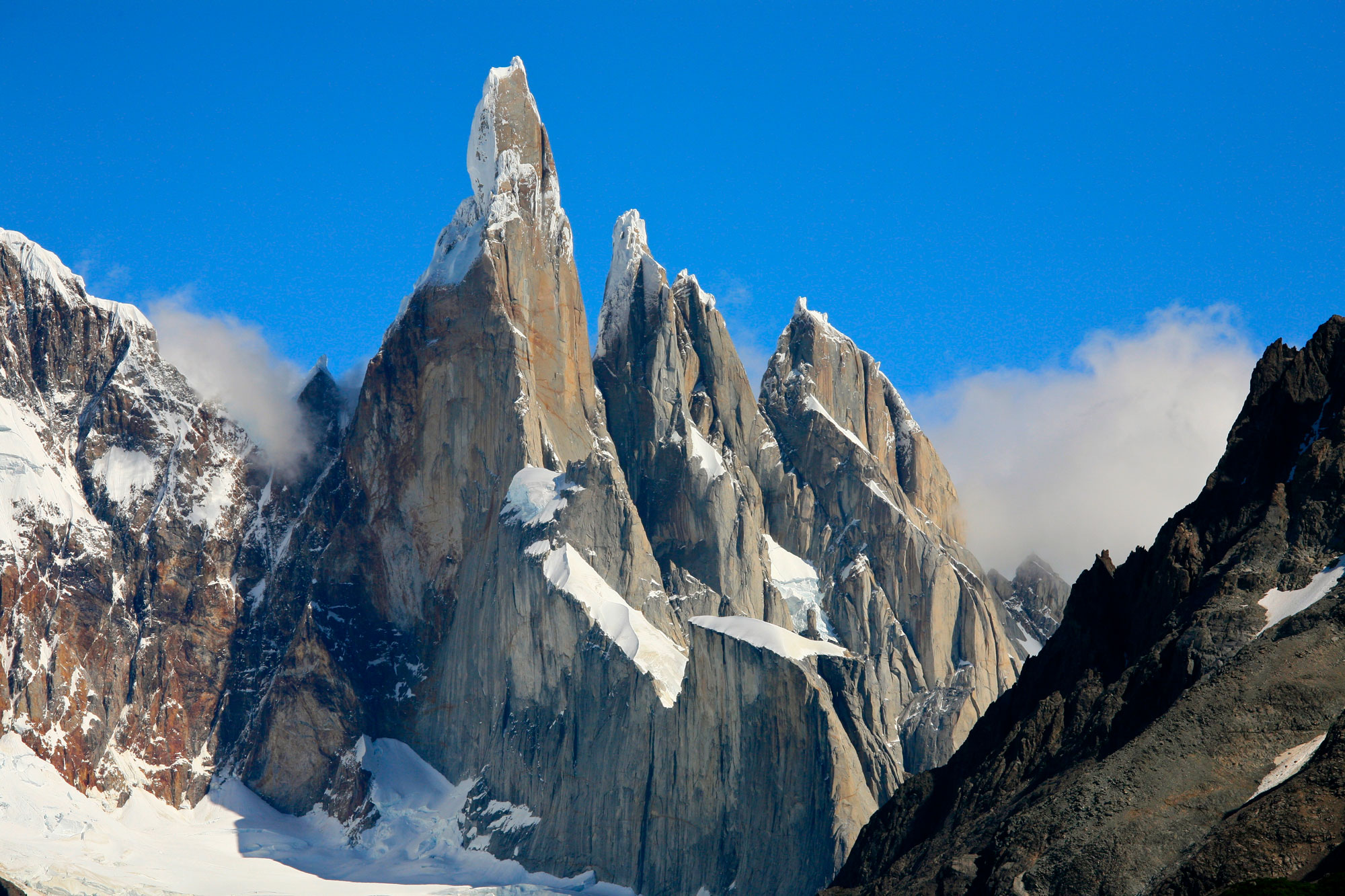 Alex Proimos from Sydney, Australia, CC BY 2.0 <https://creativecommons.org/
Alex Proimos from Sydney, Australia, CC BY 2.0 <https://creativecommons.org/licenses/by/2.0>, via Wikimedia Commons The Cerro Torre Group from the southeast. À la Recherche du Temps Perdu climbs the narrow couloir to the left of Cerro Torre leading to the notch of the Col of Hope (in cloud).François Marsigny and Andy Parkin had hoped to climb a partial new route on Cerro Torre by reaching the Col of Hope from the south via a previously unclimbed, steep and difficult 750m couloir, then continuing up the Ferrari Route on the west face. They were trapped in a storm on the Col for three days, after which they climbed a little way up the west face before retreating in further bad weather. They bailed west to the Southern Continental Icecap and then walked south for three days, covering 40 km with no food and finally reaching the shelter of Estancia Santa Fe on their ninth day out.
http://publications.americanalpineclub.org/articles/12199521001
The other nominations were:
• First ascent of Deprivation on the north buttress of Mount Hunter by Scott Backes and Mark Twight in a continuous push over the summit.
• The first one day free ascent of the Nose on El Capitan by Lynn Hill.
• Attempt on the south pillar of Nuptse East by Patrick Berhault, Michel Fauquet, Christophe Moulin, and Gérard Vionnet-Fuasset (ropes fixed).
• First solo winter ascent of the Tomas Gross route on the west face of the Aiguille du Drus by Hugues Beauzile (with portaledge). New route on the north side of Xixabangma West by Jean-Christophe Lafaille, solo.
• First solo ascent of Specchio di Sara on the south face of the Marmolada, and first ascent (with Davide Alberti) of A Quarant'anni dalla Cima on the south face of the Tofana, both by Pietro dal Pra.
Notable alpine-style ascents in 1994 that didn't make the list of nominations.
• There were many fine alpine-style ascents from various corners of the world.
• Most notable include: A new route on the southwest face of Cho Oyu, climbed solo by Yasushi Yamanoi.
• A new route on the west face of Broad Peak by Carlos Carsolio. Although Carsolio climbed alone, he completed the route in two stages, regaining his first high point via the normal route before taking an independent line to the top. Nominated for a Piolet d'Or in 1996.
• New route on the southeast face of Ama Dablam by Vladimir Bashkirov, Sergei Bogomolov, Dmitry Botov and Sergei Golubtsov. Nepalese winter ascent (December 17) of the south face of Annapurna South by Vladimir Bashkirov, Nikolia Cherny, Vladimir Lobankov, Akhamadulla Minibaev and Vladimir Shataev.
• First ascent of the west-northwest face of Langshisha Ri by Vanja Furlan, solo, traversing the summit and descending the south face.
• First ascent of the northwest face of Baruntse North by Vladimir Leitermann, Martin Otta and Tomas Pekarek.
• Dream in the Spirit of Mugs on the 900m west buttress of Eye Tooth, Ruth Gorge, by Tommi Bonapace, Raimund Haas and Andi Orgler.
• South Pillar of Combatant in Canada's Coast Range by Greg Child, Greg Collum and Steve Masceoli.
- 1996
-
In 1996 the Piolet d'Or was awarded to the first ascent of The Pearl – the south pillar of Mount Bradley (2,774m) – in the Ruth Gorge of Alaska, but also acknowledged the great contribution made to that area by Andi Orgler.
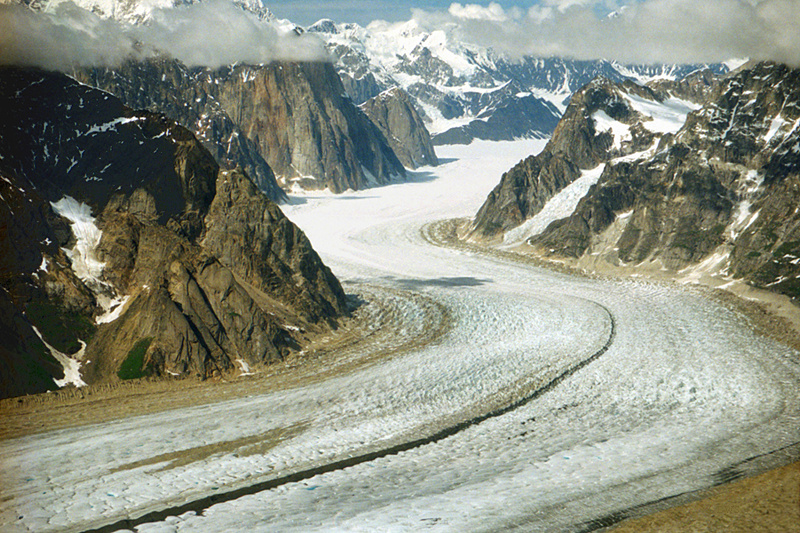 Looking north up the Ruth Gorge, Alaska, with Denali beyond in cloud Brian W. Schaller, FAL, via Wikimedia Commons <https://creativecommons.org/
Looking north up the Ruth Gorge, Alaska, with Denali beyond in cloud Brian W. Schaller, FAL, via Wikimedia Commons <https://creativecommons.org/licenses/by/2.0> From the late 1980s to the mid-1990s the Austrian Andi Orgler made many fine first ascents in the Ruth Gorge with various partners. In July 1995, with Germans Helmut Neswadba and Arthur Wutscher he spent five days climbing in alpine-style to make the first ascent of the 1,200m south pillar of Bradley: The Pearl (VIII- A3). The route didn't get a second ascent until 2013, when it was climbed at 5.12 A0 by Alex Honnold and Freddie Wilkinson.
After several notable ascents in the 1970s, the Gorge saw little serious activity until Orgler arrived on the scene in 1987, climbing the east buttress of Bradley. The following year he and Tommi Bonapace put up the 51-pitch Wine Bottle on Dickey, one of the finest alpine-style ascents established in Alaska at the time, at a high technical standard with no drilling. Much later turned from mountains to hang-gliding, where he became equally accomplished, but was killed during competition in 2007.
https://aac-publications.s3.amazonaws.com/documents/aaj/2006/PDF/AAJ_2006_48_80_086.pdf
Other ascents nominated that year
• Alpine-style second ascent of the south pillar of the Ogre, completing the pillar but descending from a point some distance from the summit (as did the first ascensionists; a complete ascent to the summit would not take place until 2001).
• Summits around the world climbed solo by Lionel Daudet. From February 1994-January 1995 Daudet climbed 12 difficult routes largely in Africa, India and Argentina.
• First ascent of Petit Prince – the south face of Aguja Saint-Exupéry, by Jérôme Arpin, Philippe Batoux, Gaël Bouquet des Chaux, Manu Pellissier and Benoît Robert. Ropes fixed for the entire ascent. Soloed two weeks later by Lionel Daudet.
• First ascent of the north face of Cholatse, by Boris Badaroux, Philippe Batoux, Marc Challamel, Christophe Mora and Paul Robach. Ropes fixed on first part of face.
• Cho Oyu speed ascent, solo, Lhotse speed ascent, solo, and Broad Peak new route on west face, solo, by Carlos Carsolio. All these ascents took place in 1994. On Broad Peak Carsolio completed the route in two stages, regaining his first high point via the normal route before taking an independent line to the top.
• First ascent of Born Under a Wandering Star – the northeast pillar of the North Tower of Paine, by Marko Prezelj and Andrej Štremfelj. Fixed ropes then capsule style with portaledge.
Other notable new routes in various parts of the world climbed in alpine-style during 1995 include:
• Ensueno on the northwest face of Fitz Roy by Mauro Girardi, Lorenzo Nadali and Andrea Sarchi.
• The northeast buttress of Tawoche, by Mick Fowler and Pat Littlejohn.
• The Elevator Shaft on the north face of Mount Johnson, Ruth Gorge, by Doug Chabot and Jack Tackle.
• First Born - the first ascent of the Fathers and Son's Wall on Denali, climbed in a continuous push by Eli Helmuth and Steve House.
• Oro del Inca on the northeast face of Huandoy Sur by Pavle Kozjek, solo.
• The Girona Couloir on the southwest face of Xixabangma, stopping on the southeast ridge just east of the main summit at ca 7,900m, by Carles Figueras and Josep Permañé,
• Southeast ridge of Makalu by Andy Collins, Dan Mazur, Alex Nikiforov and Jonathan Pratt. There was almost no new ground, but this was a coveted first alpine-style ascent.
• Extra Blue Sky on the north face of Kwangde Shar by Christophe Profit and André Rhem (to summit; Sam Beaugey and Jérôme Ruby stopped on northeast spur).
- 1997
-
The 1997 Piolet d'Or, for routes climbed during 1996, was awarded to the first ascent of the northwest face of Ama Dablam via the Stane Belak-Šrauf Memorial Route.
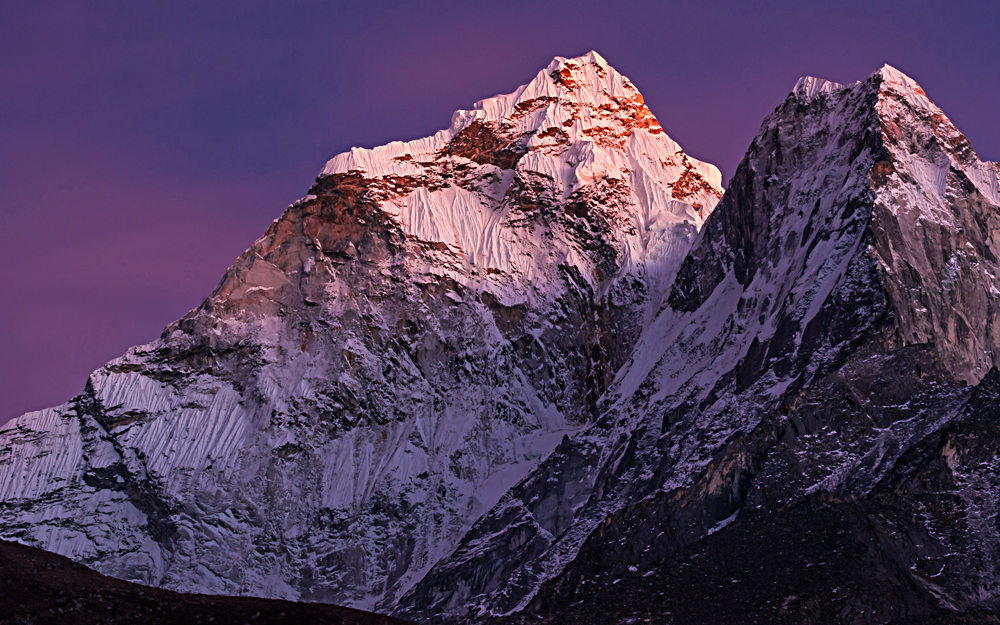 Sunset on the northwest face of Ama Dablam - Ummidnp, CC BY-SA 4.0 <https://creativecommons.org/licenses/by-sa/4.0>, via Wikimedia Commons
Sunset on the northwest face of Ama Dablam - Ummidnp, CC BY-SA 4.0 <https://creativecommons.org/licenses/by-sa/4.0>, via Wikimedia CommonsFrom April 30 – May 4, 1996, Vanja Furlan and Tomaž Humar (the latter making his first attempt on an unclimbed face in alpine-style) climbed the central part of the northwest face of Ama Dablam (6,814m), descending the southwest ridge. The ascent and descent were completed alpine-style. After a first bivouac at just over 5,600m, the pair took one and half days to climb the crux of the route, a 300m rock barrier (V+ A2+ AI5/90°). They dedicated their ascent to Belak-Šrauf, a much respected and influential Slovenian mountaineer who had died in an avalanche in his home country just six months earlier. Interestingly, on the second ascent the face was significantly more iced, and the climbers were able to negotiate the snow and ice covered "rock barrier" without too much difficulty.
Sadly, later that year Furlan was killed in a fall while climbing on the same mountain in Slovenia that took the life of Belak-Šrauf.
https://aac-publications.s3.amazonaws.com/documents/aaj/1997/PDF/AAJ_1997_39_71_005.pdf
Other ascents nominated that year
• The ascent of all 14 8,000m peaks, some in winter, by Krzysztof Wielicki, the fifth person to do so. His last, Nanga Parbat climbed in the early autumn of 1996, was completed solo in an almost continuous ascent of 48 hours.
• First ascent of Infinito Sud on the south face of Cerro Torre by Roberto Manni, Ermanno Salvaterra and Piergiorgio Vidi. A 36-pitch, big wall grade VII, climbed capsule style in 1995 to the junction with the southeast ridge, using an aluminium box instead of a portaledge.
• A new route on the north-northeast couloir and northeast ridge of Everest. Summit reached by Valeri Kokhanov, Piotr Kuznetsov and Grigori Semikolenov. Climbed in classical style with fixed camps.
• First ascent of the Pilier de la Tolérance (southeast pillar) on Mount Wake, Ruth Gorge, by Mathieu Desprats, Manu Lestienne, Manu Pellissier and Frédéric Salle. Climbed in a continuous push after previously fixing some pitches.
• The first ascent of l’Inespérée on the west face of Ulamertorssuaq West Summit by Lionel Daudet and Benoît Robert. Climbed capsule style.
• The first ascent of Cheese Finger at Three O’clock on the southwest face of the Central Pillar of Nalumasortoq by Patrick Berthet, Sonja Brambati Christian Dalphin, Jannick Flugi and Paolo Vitali. Fixed ropes.
• Climbing Gasherbrum II and Gasherbrum I in less than four days (without returning to base camp), by Jean-Christophe Lafaille, solo.
Other notable ascents from 1996, climbed in alpine-style
• The southeast face of Api, West Nepal, by Dušan Debelak and Janko Meglič.
• First ascent of Bobaye, West Nepal, via the northwest face by Tomaž Humar, solo.
• A mostly new route on the southeast face of Pumori by Zdeněk Michalec and Leopold Sulovský.
• First ascent of the Arctic Discipline Wall on Mount Kennedy, Alaska, by Jack Roberts and Jack Tackle. Climbed in a continuous push with a portaledge.
• The west face of Chacraraju, Cordillera Blanca, stopping 50m below the summit, by Dušan Debelak, Viktor Mlinar and Tomaž Žerovnik.
- 1998
-
The 1998 the Piolet d'Or was held in Chamonix, with the award going to a new route up the west face and west ridge of Makalu.
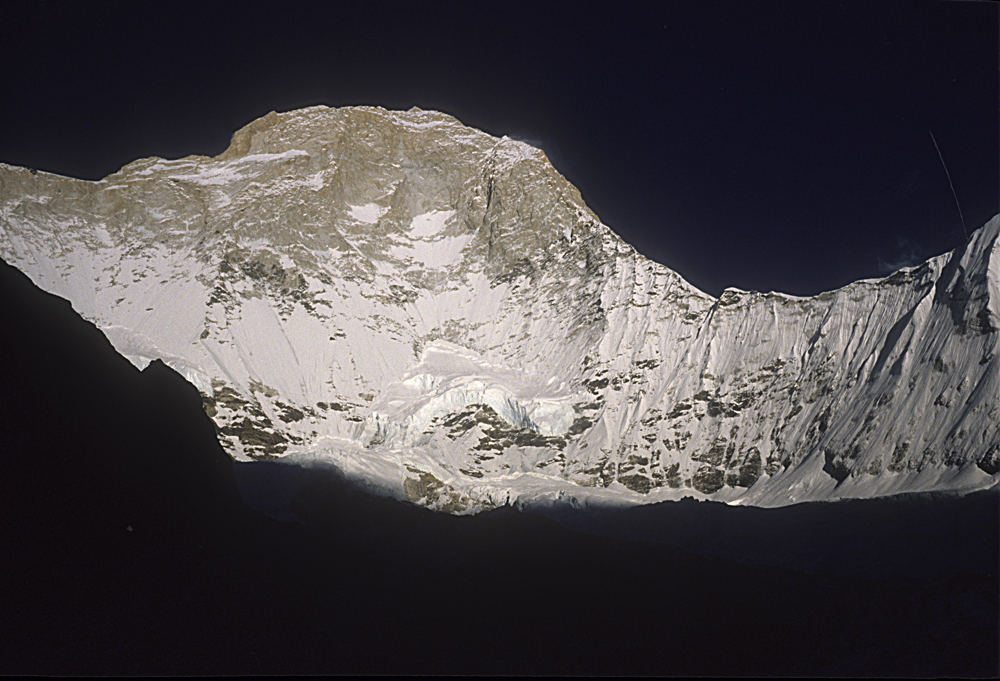 Makalu from below the west face. The Russian route climbs to the right of the large lower serac to reach the penultimate snow field below the grey headwall, then slants steeply up right to reach the crest of the West Ridge. ©Lindsay Griffin
Makalu from below the west face. The Russian route climbs to the right of the large lower serac to reach the penultimate snow field below the grey headwall, then slants steeply up right to reach the crest of the West Ridge. ©Lindsay GriffinThe year's Piolet d'Or was awarded to a new route on Makalu I (8,485m) by a team of Russians from Ekaterinburg comprising Alexey Bolotov, Sergey Buchkovski, Igor Bugachevski, Sergey Efimov, Yuri Ermachek, Salavat Khabibulin, Andrey Klepikov, Dmitry Pavlenko and Nikolay Zhilin.
The team fixed ropes up the right side of the west face, close to the west ridge. Towards the headwall they broke out right, climbing a technically difficult rock buttress on the flank of the west ridge to reach its crest above 7,900m. Subsequently, six climbers left the top camp on the ridge for a summit push, five reaching the top: Bolotov, Bugachevski, Ermachek, Pavlenko, and Zhilin. Tragically, their success was not without consequences. The sixth member, Khabibulin, had left later than the others, and was found dead on the fixed ropes by the descending party a little above the camp. The remaining climbers now faced an arduous and exhausting descent after a final push of 10 days on the face. Sadly, relatively low on the wall Bugachevski was killed by rock fall.
https://aac-publications.s3.amazonaws.com/documents/aaj/1998/PDF/AAJ_1998_40_72_011.pdf
Other ascents nominated that year
• First ascent of the north face of Changabang, in alpine-style, by Andy Cave and Brendan Murphy (to the summit; Mick Fowler and Stephen Sustad to the top of the face). All four descended the south face into the Nanda Devi Sanctuary, during which Murphy was killed by an avalanche.
• First ascent of the west face of Latok II, Pakistan, by Conrad Anker, Alexander and Thomas Huber, and Toni Gutsch. Fixed ropes then capsule style.
• First ascent of the northeast face of Rondespiret, Antarctica, from December 1996 to January 1997 by Aslak Aastorp, Robert Caspersen, Håkon Stover and Ivar Tollefsen.
• Linked ascents, in winter, of the Brooks-Colton on Les Droites, Colton- MacIntyre on the Grandes Jorasses, Cecchinel-Nominé on the Grand Pilier d'Angle and the Hypercouloir on the south face of Mont Blanc, by Patrick Berhault and Francis Bibollet.
Other ascents during 1997, carried out in alpine-style, include:
• The first ascent of the west face of Nuptse Northwest summit by Tomaž Humar and Janez Jeglič. Jeglič disappeared in the summit region in very gusty conditions and was presumed to have fallen down the south face.
• First ascent of the 2,600m east face of University Peak, Alaska, by Carlos Buhler and Charlie Sassara.
- 1999
-
The 1999 Piolet d'Or was once more held in Chamonix, where the jury comprising Guy Chaumereuil, Greg Child, Maurice Lenoir, Jean-Claude Marmier, Yves Peysson, Christophe Raylat and Yvette Vaucher awarded the first ascent of the north face direct of Thalay Sagar.
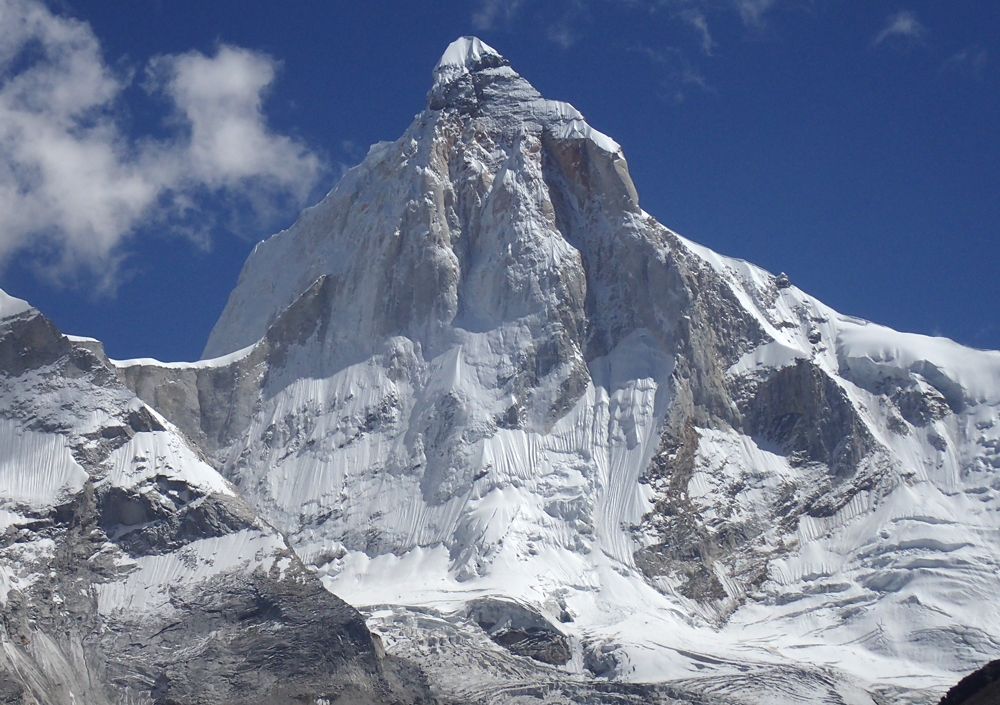 The north face of Thalay Sagar. The Australian-New Zealand route climbs the obvious, large, central couloir/depression directly below the summit. ©Sergey Nilov
The north face of Thalay Sagar. The Australian-New Zealand route climbs the obvious, large, central couloir/depression directly below the summit. ©Sergey NilovThe north face direct of Thalay Sagar (6,904m), climbed in the post monsoon of 1997, had initially escaped the attention of the Piolet d'Or organization, so was included in the nominations for the 1999 event.
After a previous attempt [1996] on the central couloir, a line that had already been tried twice by Americans, Andrew Lindblade and Athol Whimp returned in September 1997 and climbed capsule style from a portaledge up this steep ice/mixed line to the capping shale band. The steep rotten ground was overcome free, largely by dry-tooling, to reach the summit. Since that time many routes have been added to this prestigious face in the Indian Gangotri.
https://aac-publications.s3.amazonaws.com/documents/aaj/1998/PDF/AAJ_1998_40_72_070.pdf
Other nominated ascents from 1998
• First female ascent of Kangchenjunga by Ginette Harrison. Harrison was part of an expedition that climbed the Czech route on the north face in a lightweight style, with no supplementary oxygen or porters above base camp.
• A new direct line – The Lightning Route - on the north face of Changabang by Carlos Buhler, Ivan Dusharin, Andrey Mariev, Pavel Shabalin and Andrey Volkov. Climbed capsule style in 16 days at 5.9 A4 WI4 after fixing 10 pitches.
• First ascent of the northeast face of Kangtega by Erwan Le Lann, François Marsigny, Sébastien Montaz-Rosset, François Pallandre, Franck Plenier, Sébastien Schell and Hervé Qualizza. Fixed ropes on part of the route.
• A new route on the west face of Bhagirathi III by Vladimir Kachkov, Yuri Koshelenko, Andrey Lukin and Igor Potankin, climbed in capsule style (using eight fixing ropes) at 5.11 A4.
Other notable ascents during 1998 carried out in alpine-style
• First ascent of Call of the Wild (2,300m, WI6 X) on the southwest face of King Peak, St Elias Range, Canada, by Joe Josephson and Steve House.
• First ascent of the Gift that keeps on Giving (970m, 5.9 A3 WI6 X, to summit ridge) on the south face of Mount Bradley, Ruth Gorge, Alaska, by Jonny "Blitz" Carpenter, Steve House and Mark Twight.
• First ascent of the east face of Kusum Kanguru via Never Ending Story (1,200m, 5.9 AI4) in a continuous push, up and down, of 35 hours, by Yasushi Yamanoi, solo.
• The south rib to the south summit of Drohmo by Roger Mear and Doug Scott (first four pitches fixed).
- 2000
-
In the first year of the new millennium the Piolet d'Or was held at a new venue: the annual International Ice Climbing Festival in Argentière la Bessée. The jury, comprising Guy Chaumereuil, Philipp Descamp, Emmanuel Guy, Luc Jourjon, Andrew Lindblade, Yves Peysson, Christophe Profit and Athol Whimp, awarded the 2000 Piolet to the first ascent of the southeast face of Birkett Needle.
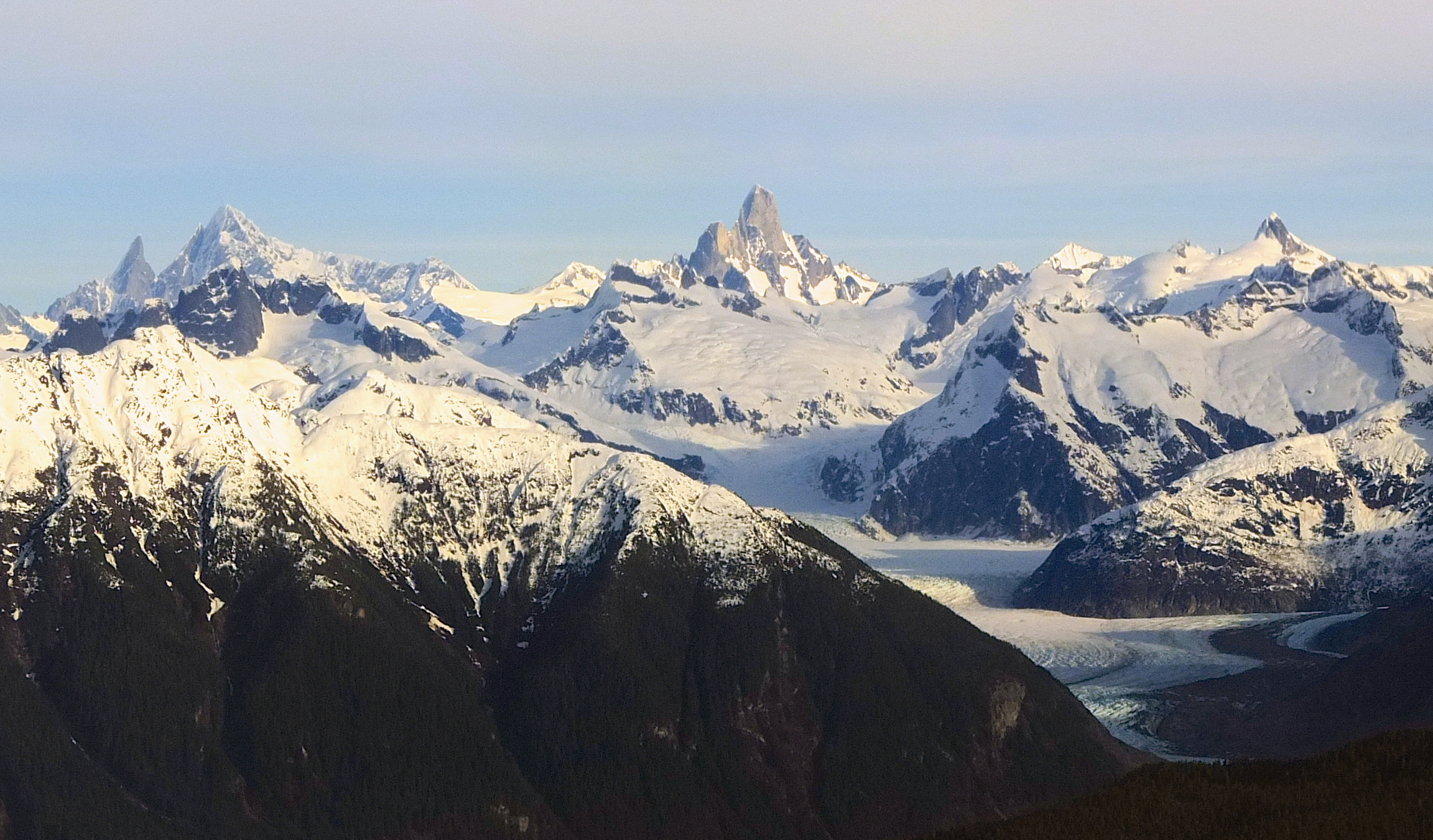 The Devil's Thumb Group, Stikine Icefield, Alaska, with the Devil's Thumb centre and Burkett Needle far left. Joseph from Cabin On The Road, USA, CC BY-SA 2.0 <https://creativecommons.org/licenses/by-sa/2.0>, via Wikimedia Commons.
The Devil's Thumb Group, Stikine Icefield, Alaska, with the Devil's Thumb centre and Burkett Needle far left. Joseph from Cabin On The Road, USA, CC BY-SA 2.0 <https://creativecommons.org/licenses/by-sa/2.0>, via Wikimedia Commons.In a total of 41 days in Alaska's Coast Range, without radio contact or assistance, Lionel Daudet and Sébastien Foissac made the first ascent of the southeast face of Birkett Needle (2,590m) via a route they named Voyage of the Celestial Tramps (1,200m, 7a+ A3+). After being dropped at the coast by boat, the pair made a six-day journey to the mountain towing pulks. Climbing in capsule style from a portaledge, the two battled poor weather to reach the summit. After descending, and with little time left before their pre-arranged pick up, the pair walked 15-17 hours a day back to the coast, pulling haul bags instead of pulks that had been blown away by the fierce wind. Birkett Needle lies on the Stikine Icecap and was first climbed in 1964 by Dan Davis and Layton Kor.
http://publications.americanalpineclub.org/articles/12200021702
Other nominated ascents from 1999
• New route on the south-southeast face of Dhaulagiri (not to summit) by Tomaz Humar, solo. Seven days of alpine-style climbing to exit onto the southeast ridge 170m below the summit. From here he traversed to the normal route and descended.• First ascent of High Tension, a new route on the north face of Thalay Sagar by Alexei Bolotov, Mikhail Davy, Alexander Klenov and Mikhail Pershin. Climbed capsule style from a portaledge with some drilled protection/aid.
• First ascent of the northwest face of Great Trango Tower via the route Parallel Worlds (ca 1,800m, 5.11 A4) by Alex Lowe, Jared Ogden and Mark Synnott. Capsule style with drilled gear.
• First ascent of Sol Solet (1,650m, 6c+ A5 60°) on the west face of Amin Brakk by Pep Masip, Miquel Puigdomenech and Silvia Vidal. Capsule style with some drilled gear.
• First ascent of Eldorado (1,100m, 6b A3/A4 90°) on the north face of the Grandes Jorasses by Valery Babanov, solo, in 12 days using a portaledge.
Other ascents not nominated that were carried out in alpine-style during 1999 include:
• First ascent of Arwa Tower, Garhwal, India, via the northwest face (1,000m, Scottish VI A3) by Mick Fowler and Stephen Sustad.
• First ascent of the 2,000m north face (M4 55°) of Gyachung Kang by Marko Car, Tomaz Jakovic, Matic Jost, Peter Mezner, Marko Prezelj and Andrej Stremfelj
• First ascent of the 1,500m northwest pillar of the west summit of Chuchubalstering, Hindu Raj, Pakistan, by Stéphane Benoist, Bruno Ravanat and Jérome Thinières.
• First ascent of the northwest ridge (5.11 WI5) of Cerro Standhardt, Patagonia, Argentina, by Nathan Martin and Tim O'Neil.
• New route on the south face of Mt Foraker (2,850m, Alaskan 6), Alaska, by Steve Larson and Joe TerraVecchia.
• First ascent of M-16 (1,000m, WI7) on the east face of Howse Peak by Scott Backes, Barry Blanchard and Steve House.
- 2001
-
The Piolet d'Or was again held in conjunction with the International Ice Climbing Festival in Argentière la Bessée, where the jury comprised of Guy Chaumereuil, Lionel Daudet, Philippe Descamp, Sébastien Foissac, Hubert Giot, Luc Jourjon, Paul Keller and Simon Richardson made the award to the first ascent of the direct north pillar of Shivling.
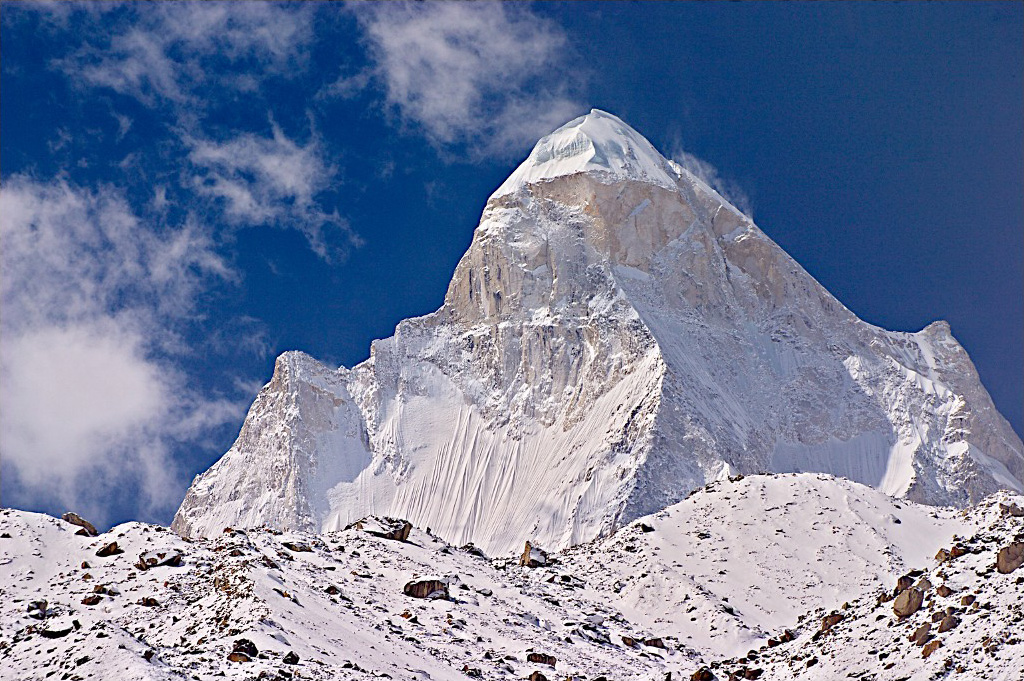 Shivling, with the north ridge facing the camera. The direct north pillar follows this line to the summit through the vertical to overhanging headwall and snow slopes above. Anirban Biswas from Kolkata, India, CC BY-SA 2.0 <https://creativecommons.org/licenses/by-sa/2.0>, via Wikimedia Commons.
Shivling, with the north ridge facing the camera. The direct north pillar follows this line to the summit through the vertical to overhanging headwall and snow slopes above. Anirban Biswas from Kolkata, India, CC BY-SA 2.0 <https://creativecommons.org/licenses/by-sa/2.0>, via Wikimedia Commons.Alex and Thomas Huber had come to the Gangotri, India, to attempt a direct finish to the north ridge of Shivling (6,543m), a line climbed in part by the Japanese in 1980 and by Hans Kammerlander and Christophe Hainz in 1993. When Alex became ill with tonsillitis and a high fever, Thomas teamed with Iwan Wolf, a member of a Swiss expedition to Shivling planning to try the 1980 Japanese route. Ropes were fixed to around 5,900m. Huber led the impending prow of the headwall via difficult aid on dangerous rotten rock. No drilling took place and the 400m of new ground – Shiva's Line – was graded UIAA VII A4 70°. The entire route was 1,440m, VII A4 M6. The pair descended the same route from the summit.
https://aac-publications.s3.amazonaws.com/documents/aaj/2001/PDF/AAJ_2001_43_75_079.pdf
Other ascents nominated that year
• First ascent of the north face of Kantega (6,799m), Nepal, terminating on the northwest ridge at 6,600m, by Valery Babanov, solo. The 1,200m route was climbed in capsule style and graded ED+, 5c/6a A2/3 M6 80°.
• A new route on the Golden (northwest) pillar of Spantik (7,028m), Pakistan, by Mikhail Davy and Alexander Klenov, who climbed the Russian Route (7a A3) over 12 days with a portaledge.
• First ascent of The Knowledge (1,200m, ED4 5.7 A2++ WI6) on the north buttress of Mount Hunter, Alaska, as far as the Cornice Bivouac. Alpine-style using a single person portaledge.
• First uncontested solo ascent of No Siesta (6b A2 90°) on the north face of the Grandes Jorasses by Patrice Glairon-Rappaz.
• First ascent of Anissa (1,200m, 7a A3) on the west face of Ketil, Greenland, by Eduardo Alonso and David Jonglez in capsule style.
Other notable ascents in 2000, carried out in alpine-style included:
• First ascent of the 2,100m southwest face of Xixabangma West, Tibet, via the route Nyong Mong (80°) by Eloi Callado and Eduardo Sanchez in a six-day alpine-style ascent from a base camp in the Langtang Valley.
• First ascent of the Arwa Spire (6,193m, east summit), India, via the northeast ridge by Andy and Pete Benson – 2,000m, TD+ 5.9 WI4.
• First ascent of Freebird (1,000m, VI 5.11d A1) on Cat's Ears Spire, Pakistan, by Jonathan Copp and Mike Pennings; a fast and lightweight ascent of this difficult rock route.
• First ascent of the south summit (7,350m) of Jongsang via the 1,200m south face – Touch of Silence – by Urban Asman and Andrej Markovic in a 16-hour push. During the descent at night Markovic was killed in a rappelling accident.
• The east face of Mascara, Patagonia, Chile, via the new route For a few Dollars More (800m 7a A3), climbed alpine style with no portaledge after fixing the first 150m by Mike "Twid" Turner and Louise Thomas.
• And although not new routes, the single push ascent of the Slovak Route (2,700m, 5,9 X M6 WI6+) on Denali, Alaska, by Scott Backes, Steve House and Mark Twight, and the 26-hour continuous ascent of the 3,600m Thunderbird Variation to the Hummingbird Ridge on Mount Logan by Werner Stuckli and Christian Zinsli, were truly notable. Travelling with very minimal equipment the last-named climbers crossed the summit and made a blind descent the east ridge in poor weather.
- 2002
-
For the third year in a row the Piolet d'Or was held in conjunction with the International Ice Climbing Festival at Argentière la Bessée. The jury, which that year comprised Chris Bonington, Guy Chaumereuil, Philippe Descamp, Hubert Giot, Luc Jourjon, Thomas Huber, Robert Paragotand Iwan Wolf, made the 2002 award to the first ascent of Meru Central .
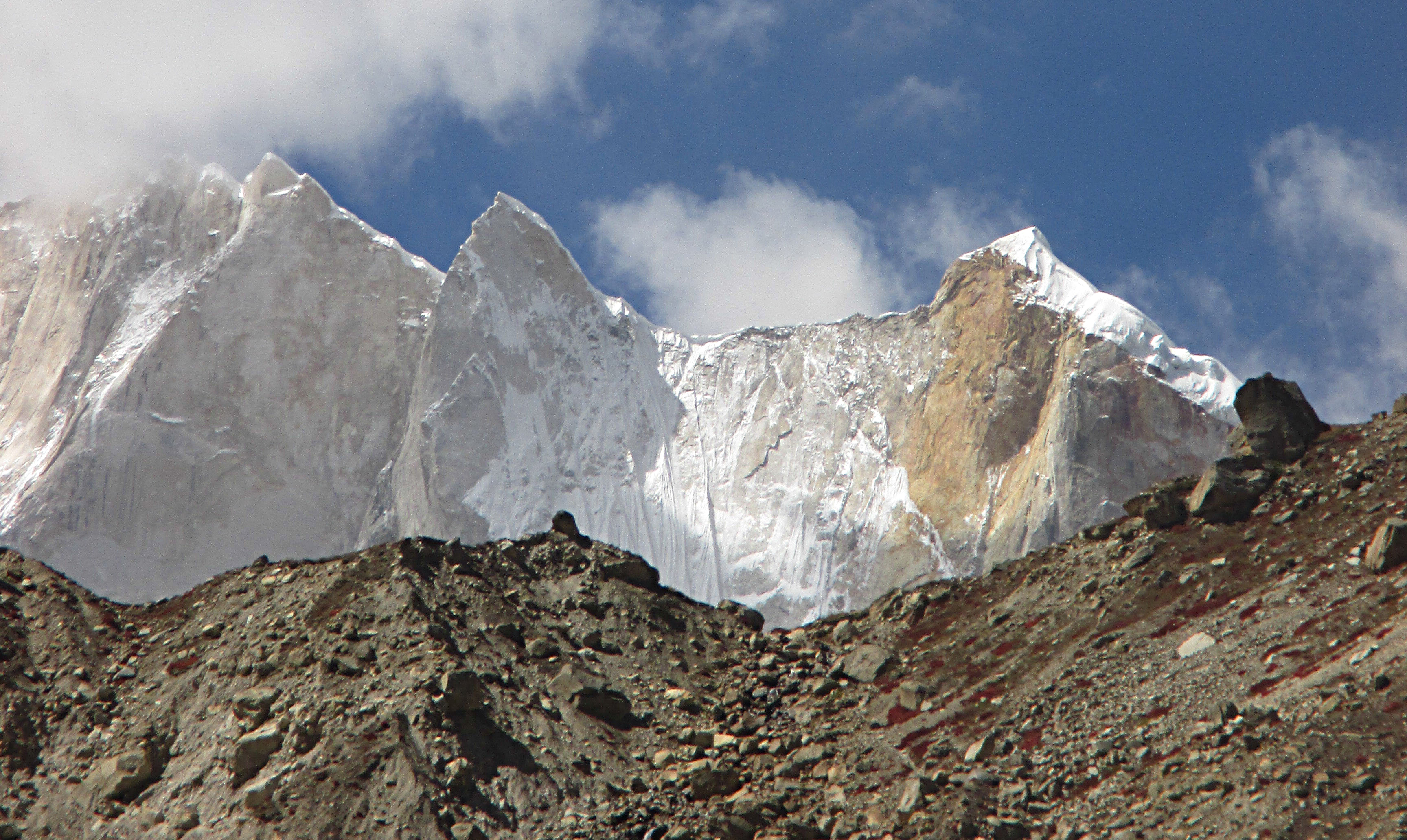
The Meru Group, with Meru Central the sharp middle peak. The original route climbed the fluted snow/ice slope to reach the ridge right of the summit. DipankarSen68, CC BY-SA 4.0 <https://creativecommons.org/licenses/by-sa/4.0>, via Wikimedia Commons.
The unclimbed Meru Central (6,310m) was already a very well-known objective in 2001 due to the spectacular granite prow of the east pillar, which had seen around a dozen attempts. Dubbed the Shark's Fin by a British team that had tried it in the early 1990s, it was attempted in the spring of 2001 by the Russian soloist, Valery Babanov, but bad weather stopped him at around 5,800m. He returned in the autumn to find the wall much drier and considerably more dangerous from rockfall, so opted for a line further right, previously attempted by Americans. This would be an easier route and logical for a solo ascent. He fixed ropes on this line up to around 5,800m, and installed a portaledge at 5,600m. From that camp he made a summit push, climbing the steep upper snow/ice of the northeast face to make a difficult exit through corniced terrain onto northwest ridge, which he followed to the highest point. The route was named Shangri La (F5c/6a A1/A2 M5 75°).
https://aac-publications.s3.amazonaws.com/documents/aaj/2002/PDF/AAJ_2002_44_76_176.pdf
The other nominated ascents from 2001
• The first ascent of Light Traveler on the southwest face of Denali (6,193m), Alaska, by Stephen Koch and Marko Prezelj in a single-push ascent of 48 hours.
• First ascent of Women and Chalk on the 1,150m east face of Shipton Spire (5,850m), Pakistan, by Mauro "Bubu" Bole, Mario Cortese and Fabio Dandri in capsule style over 13 days.
• The first ascent of Lhotse Central (8,414m) Népal, by a large Russian team with the summit reached by Alexey Bolotov, Nikolay Gilin, Yuri Koshelenko, Petr Kuznetsov, Gleb Sokolov, Sergey Timofeev, Evgeny Vinogradsky, Victor Volodin and Vladimir Yanochkin. Fixed ropes, with oxygen used by all above 8,000m
• First ascent of The Beast on the east face of Mooses Tooth (3,150m) Alaska, by Jim Bridwell et Spencer Pfingsten. Fifty-nine days of effort over 2000 and 2001.
• A non-mechanized traverse of the Alps from Triglav to the Alpes Maritime by Patrick Bérhault, who climbed 22 high standard routes along the way, linking these on foot (by walking, skiing and snowshoeing).
Notable ascents not mentioned above, climbed in alpine-style during 2001 included:
• First ascent of the northwest ridge of Ama Dablam, Nepal, by Julian Cartwright and Rich Cross. This 2001 ascent somehow missed the attention of the Piolet d'or committee in 2002 but was nominated for the 2003 award.
• A new route on the west face of Pumori, Nepal, and traverse of the mountain by Ueli Buhler and Ueli Steck.
• First ascent of the east pillar and southeast face of Kangtega by Olivier Besson, Christophe Profit and André Rhem,
• First ascent of Yamandaka (6,128m), Indian Karakoram, via the route Barbarossa on the north face (1,200m, 5.9 A2), followed by a descent of the south face into an unknown valley, by Mark Richey and Mark Wilford.
• First ascent of The Extraterrestrial Brothers (2,200m, ED 2 Scottish VII) on the Fathers and Sons Wall of Denali by Kenton Cool and Ian Parnell.
- 2003
-
In 2003 the Piolets d'Or moved to Paris and the Espace Cardin. On this occasion the jury, which included Valery Babanov, Christian Beckwith, Paul Braithwaite, Guy Chaumereuil, Philippe Descamps, Hubert Giot, and Gérard Vionnet-Fuasset, voted to award the first ascent of the northwest face of Siguniang.
The northwest face of Siguniang. The 2002 route, dubbed The Inside Line, follows the thin ice runnel above the arrow, then outflanks the summit seracs on the right.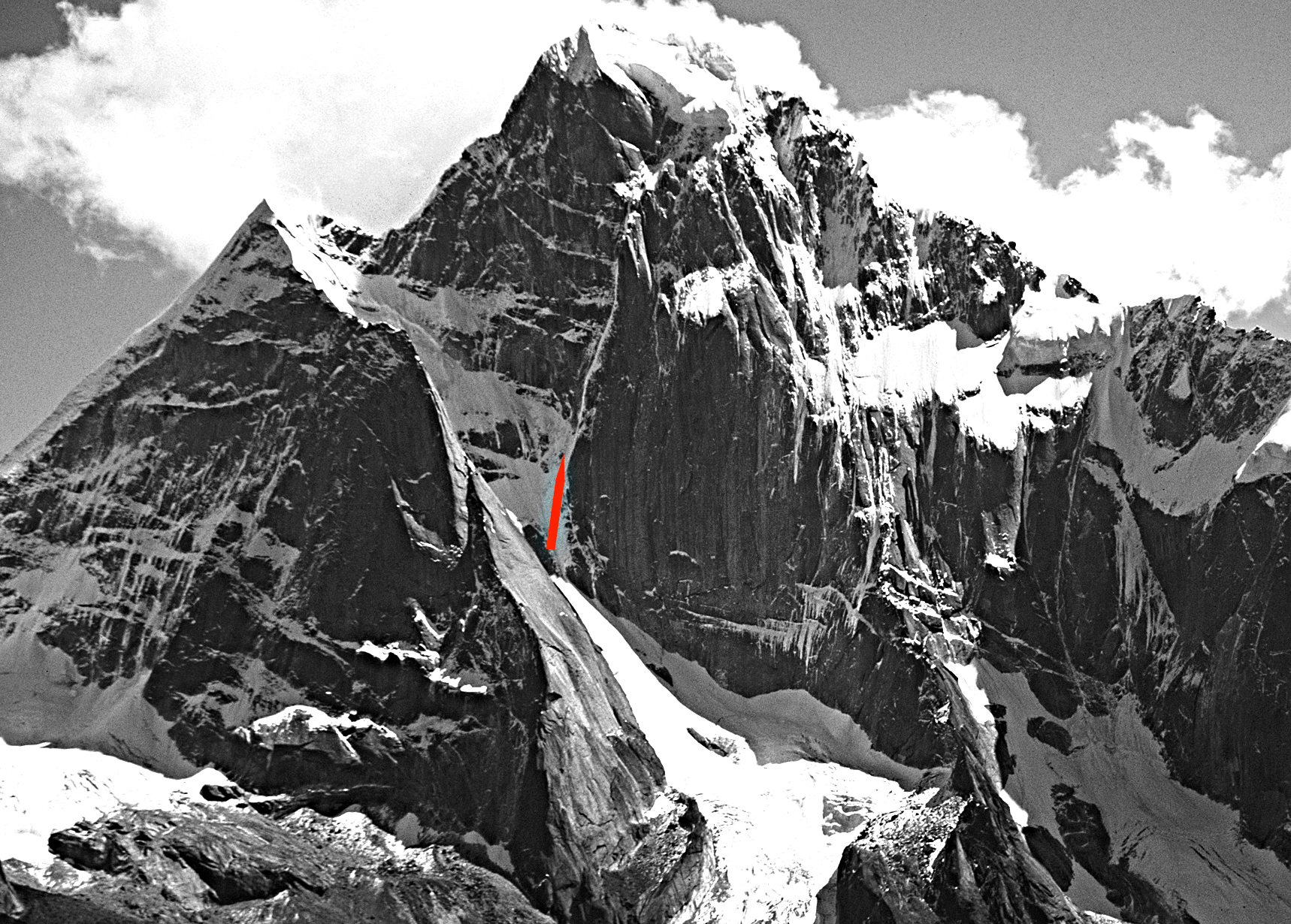
Tipped off by an American expedition, which had tried this spectacular peak in 1981, Mick Fowler and Paul Ramsden travelled to the Siguniang National Park in Sichuan, China, to attempt a thin, north-facing basalt dyke, chocked with ice, on the northwest face of Siguniang (6,250m), the region's highest mountain.
Making five bivouacs on the ascent, most of which were quite unpleasant, the two climbers overcame consistently steep terrain with several long pitches of near vertical ice and two overhanging sections, completing what has been dubbed The Inside Line (1,500m, AI6 M6). They descended the unclimbed north ridge.
This was the first, big, new mountain route to come from the Fowler-Ramsden partnership, and several more of their later ascents would also be awarded Piolets d'Or.
http://publications.americanalpineclub.org/articles/12200316000
Other nominated ascents from 2002
• First ascent of the northwest ridge (2,300m, ca 4,000m of climbing, Scottish 6) of Ama Dablam (6,858m), Nepal, by Jules Cartwright and Richard Cross with nine bivouacs on the ascent. This ascent took place in 2001.
• The east ridge of Annapurna (8,091m), Népal, by Alberto Iñurrategi and Jean-Christophe Lafaille. This was the first occasion the route had been climbed and descended. The pair climbed alpine-style above Camp 3 at 7,100m, making two bivouacs on the ascent to Annapurna I.
• First ascent of Fior di Vita (780m, VI+ A2 80°) on the north face of Arwa Spire, Garhwal, India, by Stephan Harvey, Bruno Hasler and Roger Schaeli. This route, climbed in a lightweight capsule style, led to the main summit. The same team climbed a more difficult route, Capsico (850m, M6+ A3), to the unclimbed west summit using fixed ropes.
• Three solo ascents in the Chalten Group by Dean Potter: a free-solo of the Supercanaleta on Fitz Roy; a speed solo (roped for one pitch) of the Compressor Route on Cerro Torre in 8½ hours; the first ascent, free-solo, of Californian Roulette on Fitz Roy.
• A new route Crise del Fe (900m, 6a A4 M5+) on the south face of Huandoy Sur (6,130m), Peru, by Yann Bonneville, Benoît Chanal, François Dupety and Pierrick Keller. The ascent, using fixed ropes, was made in 17 days spread over almost a month.
Other notable ascents in 2002, climbed in alpine-style
• First ascent of the 1.400m west face (M6 WI5) and second overall ascent of Swachand (6,721m), Gangotri, India, in four days by Guy Edwards and John Miller.
• First ascent of the 1,600m southwest face (D) of Chaukhamba II (7,070m) and traverse of the summit by Yannick Graziani, Greg Sauget, Christian Trommsdorff and Patrick Wagnon.
• First ascent of the northwest buttress of Arwa Tower (600m, 6b), Garhwal, India, by Antoine de Choudens, Laurent Miston, Gregory Muffat and Dimitry Munoz.
• First ascent of Khanadan Buttress (1,300m, 5.11 C1) on Shipton Spire, Pakistan, with two bivouacs, by Bruce McMahon and Josh Wharton.
• First ascent of the north face of Ngozumpa Kang II (7,743m), Tibet, by Mike Bearzi and Bruce Miller, though sadly Bearzi was killed during the descent.
• Probable new route on the west face (1,500m, TD+, two bivouacs) of Peak 41 (6,645m), Nepal, by Urban Golob, Matic Jost and Uros Samec.
• First ascent of Blood from the Stone (1,600m, 5.9 A1 M7+ AI6+ X) on the east face of Dickey, Ruth Gorge, Alaska, by Sean Easton and Ueli Steck.
• First ascent of Howse of Cards (ca 1,000m, M7- WI6 X) on the north face of Howse Peak in the Canadian Rockies by Will Gadd, Kevin Mahoney and Scott Semple.
- 2004
-
After moving to Paris for the 2003 event, the 2004 Piolet d'or returned to nearer the Alps: the Alpes Congrès in Grenoble. The 12th Piolet d'Or was awarded to the first ascent of Nuptse East via the southeast pillar.
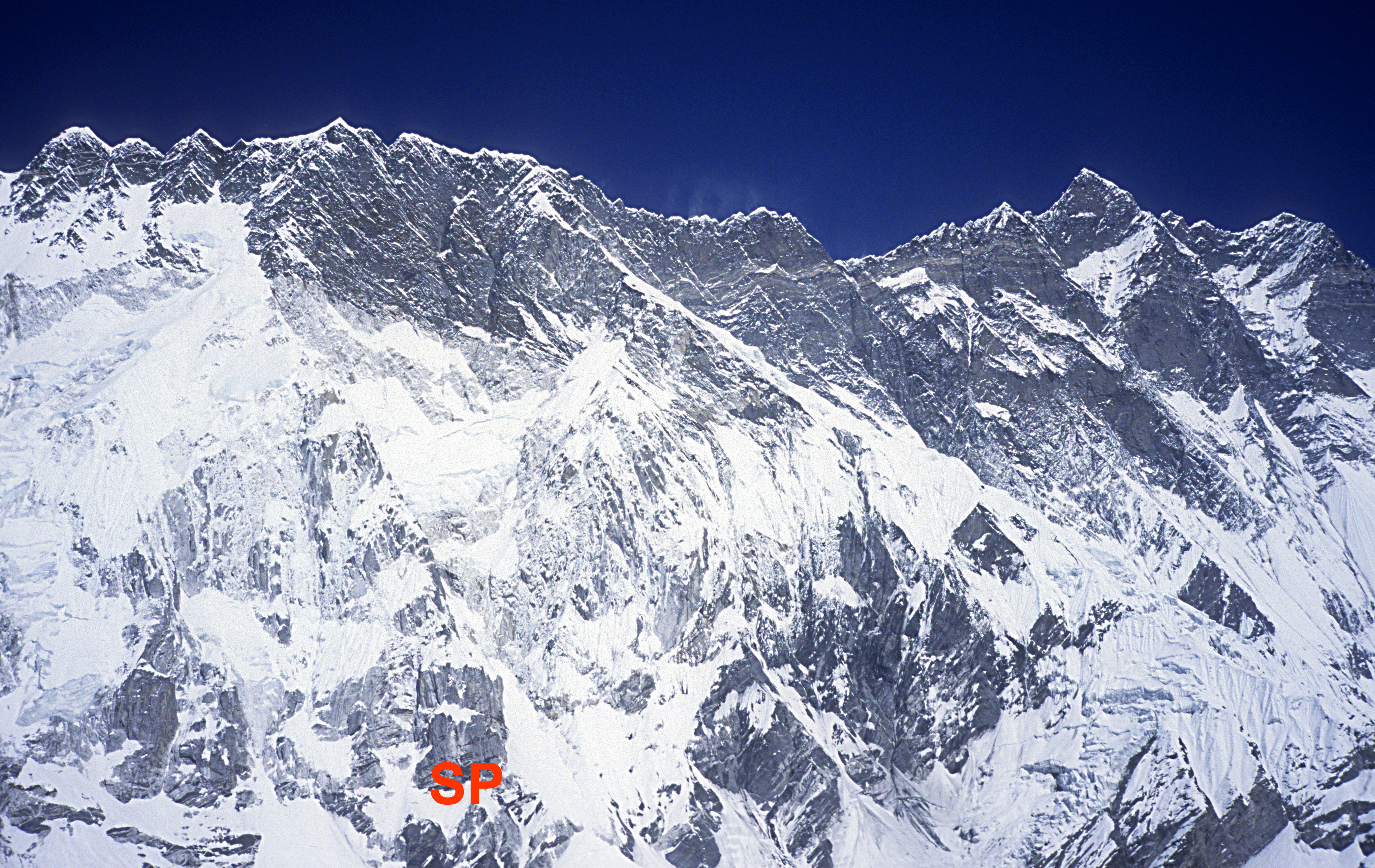
The South Pillar of Nuptse East follows the leftward slanting snowed up rock pillar to the snow slopes above, then from the top of these slants up right to the pointed summit. Lindsay Griffin Collection.
In the post monsoon season, on his third attempt in a little over a year, Valery Babanov, with fellow Russian Yuri Koshelenko climbed the much-coveted line of the southeast pillar of Nuptse East (7,804), a previously untrodden summit. Starting at around 5,400m, an initial 1,000m of technical climbing (6b A3 80-90°) leads to the top of the Devil's (a.k.a Diamond) Tower and had already been climbed on six previous occasions, with earlier attempts in alpine-style. The two Russians fixed rope to the top of the Tower, and on their first summit attempt climbed in alpine-style above the Tower to 6,900m before retreating. On the second attempt they reached the top after a very difficult and committing final day on M4+ mixed ground. Arriving on the summit under a bright moon led to the route name: Moonlight Sonata.
http://publications.americanalpineclub.org/articles/12200402400
Other nominated ascents from 2003
• First ascent of One Way Ticket on the northwest face of Thalay Sagar, India, by Stéphane Benoist and Patrice Glairon-Rappaz in alpine style with a portaledge.
• First ascent of the southwest ridge of Annapurna III, Nepal, in alpine-style by Kenton Cool, Ian Parnell and John Varco.
• Solo ascents of the normal route on Dhaulagiri, the normal route on Broad Peak and a new line (with Simone Moro) on the Diamir face of Nanga Parbat, close to the 1978 Slovak Route, all by Jean-Christophe Lafaille. The line on the Diamir Face joined the normal Kinshofer Route at 7,100m, which Lafaille followed to the summit.
• First ascents of En lo Alto, el Viento sera Nuestra Recompensa on Chacraraju Este (not to summit), Cordillera Blanca, Peru, in alpine-style, and Tambo, Churros y Amigos on the east face of Jirishanca, Cordillera Huayhuash, Peru in capsule style, by Aymeric Clouet and Didier Jourdain.
• First ascent of the Super Dupa Couloir on the east face of the Citadel, Alaska, in alpine-style by Stuart McAleese, Ollie Sanders and Mike " Twid" Turner.
• First ascent of Last Cry of the Butterfly on the east face of the Citadel, Alaska, in capsule-style, by Krzysztof Belczynski, David Kaszlikowski and Marcin Tomaszewski.
Notable ascents not mentioned above, climbed in alpine-style during 2003, included:
• First ascent of the 1,500m Crystal Snake (5.9 A0 WI5 M4) on the north face of Nuptse, with a few ropes fixed on the initial pitches, by Damian and Willie Benegas.
• First ascent of La Luce del Nirvana, a partial new route on the southwest face of Kangchenjunga (8,586m) by Christian Kuntner, Mario Merelli, Silvio Mondinelli and Carlos Pauner. They followed the normal route to ca 7,950m then moved right and climbed direct to the summit (around 500m of new ground at V 60°). No fixed ropes or oxygen.
• First known ascent of Kyashar (6,770m) via the west ridge by Sam Broderick, Andi Frank and Bruce Normand.
• First ascent of the north face of Pharilapcha (6,017m), Nepal, via Bonfire of the Vanities (1,000m, M5 WI4) by Sébastien Constant and Jérôme Mercader.
• First ascent of Great White Fright (1,800m, ED2) on the Father and Sons Wall of Denali, Alaska, by Paul Ramsden and Guy Willet in a 50-hour continuous push.
• New routes on the east face of Huandoy Norte (6,395m. TD+), and the southeast face of Huandoy Este (5,900m, TD/TD+) by Adam Kovacs, solo.
• First ascent of Fear and Loathing (25 pitches, ED3 WI6+, not to summit) on the southeast face of Jirishanca (6,126m), Peru, by Nick Bullock and Al Powell.
- 2005
-
The 2005 Piolet d'Or again took place in Grenoble where a jury comprising Valery Babanov, Stéphane Benoist, Guy Chaumereuil, Philippe Descamps, Leslie Fucsko, Yvette Vaucher (the first women to appear on a Piolet d'Or jury) and Krzysztof Wielicki, made the award to the first ascent of the Direct north face of Jannu.
The Russian direct on the north face of Jannu climbs the left-slanting snow ramp and precipitous rock wall directly below the summit. Lindsay Griffin Collection.
In the pre-monsoon season a primarily Russian expedition made the much-coveted first ascent of the Direct north face of Jannu (7,710m), Nepal. The team comprised Mikhail Bakin (Doctor), Sergey Borisov, Gennady Kirievskiy, Mikhail Mikhailov, Alexander Odintsov (Leader), Dmitry Pavlenko, Mikhail Pershin, Evgeny Prilepa, Alexander Ruchkin, and Nikolay Totmyanin. The previous year many of the same climbers had attempted the route, retreating from 7,100m. Some of the fixed ropes left in place would prove helpful to the 2004 team.
The expedition made a series of portaledge camps during the ascent of the 72-pitch quasi-vertical wall (the height of the entire route was 3,250m) and there was gradual attrition of the climbers, causing Ruchkin to write, "it was like war, with teammates returning [to advanced base camp] from the route as if from battle". However, with characteristic perseverance and huge team spirit the climbers continued, with the summit eventually reached first by Pavlenko and Ruchkin. They were followed a day later by Borisov, Kirievskiy and Totmyanin. Over 3,000m of rope were fixed on difficulties up to 6b A3+ WI4 M6. This fixed rope was found so badly frozen on the descent that only some of it could be removed.
The award proved to be one of the most controversial presented at Piolet d'Or ceremonies, and although an historic ascent in Nepalese Himalayan climbing, it was unpopular with the public. For the first time in the history of the Piolet d'Or the organizers introduced a "public prize", where the audience voted its own award. This went to the south face of K7 (below), a route climbed in diametrically opposite style to that employed by the Russians.
http://publications.americanalpineclub.org/articles/12200505600
Other nominated ascents from 2004
• New route on the south face of K7, Pakistan, and the second ascent of the 6,934m summit by Steve House in a single push of nearly 42 hours base camp to base camp (27 hours for the 2,400m of ascent).
• A solo ascent of the southwest face of Xixabangma, Tibet, in early December via a variation to the British Route, by Jean-Christophe Lafaille (300m of rope fixed).
• First ascent of Linea di Eleganza on the northeast face of Fitz Roy, Argentina, by Horacio Codò, Lucas Fava and Elio Orlandi. Fixed ropes to a good ledge at half-height, then working from a base on this ledge ropes were fixed toward the summit.
• First ascent of Mobitel's Swallow-Johan's Route on the south face of Aconcagua, Argentina, by Tomaž Humar and Aleš Koželj climbing alpine-style and descending the normal route on the north flank of the mountain.
• First ascent of Arctic Rage on the east face of Mooses Tooth, USA, by Ben Gilmore and Kevin Mahoney in alpine-style, rappelling the route.
Other notable ascents in 2004, climbed in alpine-style
• First ascent of the southeast face and south ridge (1,550m, ED M5) of Pasang Lhama Chuli (7,351m), Nepal, by Rok Blagus, Samo Kremelj and Uros Samec.
• First ascent of Ciao Patrick (V+/VI M6+ 90°) on the northwest face and northwest ridge of Baruntse North (7,057m) by Simone Moro, Bruno Tassi and Denis Urubko. The route lies parallel to the 2004 Czech ascent in the lower half but climbs very similar ground in the upper.
• First ascent of the 2,000m central rib of the northwest face of Saf Minal (6,911m), India, and second ascent of the mountain, by Ian Parnell and John Varco with five bivouacs on the ascent.
• First traverse of all eight Mazeno peaks (highest 7,120m) on the west-southwest ridge of Nanga Parbat, Pakistan, descending from the Mazeno Col (6,940m), by Doug Chabot and Steve Swenson.
• First ascent of Lord of the Towers (800m, 6a A1 AI6 90°) on north face of Chacraraju Oeste (6,112m), Peru, by Marjan Kovac, Pavle Kozjek and Aritza Monasterio. Stopped on the east ridge.
• First ascent of Snowpatrol (1,500m, ca 40 pitches, WI5+ 90°) on the southeast face of Mt Dickey, USA, by Sam Chinnery and Andy Sharpe, who descended the west face.
- 2006
-
The 2006 Piolet d'Or was once again held in Grenoble, where the jury of Alexei Bolotov, Guy Chaumereuil, Philippe Descamps, Pierre Hofmann, Silvo Karo, Francois Marsigny, Mikhail Mikhaïlov, Mike "Twid" Turner, Stephen Venables and Im Duc Young made the award to the first ascent of the Central Pillar of Nanga Parbat's Rupal Face.

The Central Pillar of the Rupal Face of Nanga Parbat. The 2005 Anderson-House route weaves through snowslopes and rock barriers left of centre, before heading back right at the top. By Maariz - Own work, CC BY-SA 4.0, <https://commons.wikimedia.org/w/index.php?curid=69032971>.
Over six days in September 2005 Vince Anderson and Steve House made the first ascent of the Central Pillar of the southeast (Rupal) face of Nanga Parbat (8125m), Pakistan. With another partner, House had attempted a similar line, which lies between the Messner Route and Southeast Pillar, the previous year, reaching ca 7,500m. In 2005 the crux of this more than 4,000m-high wall above the Bazhin Glacier was at around 5,300m - poorly protected dry tooling up loose 5.9 granite. The two made their final bivouac of the ascent at 7,400m and reached the summit from there in a 24-hour round trip, having joined the Messner route at 7,900m. They descended in a further two days via the Messner route, which had recently been repeated in siege-style. The Central Pillar was rated 5.9 WI4 M5X and completed in perfect alpine-style.
http://publications.americanalpineclub.org/articles/12200601400
Other nominated ascents from 2005
• First ascents of Chomo Lonzo North (via northwest ridge) and Central (via the north peak and north ridge), Tibet, by Yannick Graziani, Christian Trommsdorff and Patrick Wagnon, in alpine-style.
• A new direct finish to the French route on the north face of Cholatse (one bivouac on the ascent and one on the descent) and a new route on the southeast face of Tawoche (in a day), Nepal, by Ueli Steck, solo.
• First ascent of the 2,500m southwest face of Broad Peak, Pakistan, by Denis Urubko and Sergey Samoilov, who climbed in alpine-style over six and a half days.
• First ascent of the 1,200m north pillar of Cerro Murallon, Argentina, to the summit plateau, via Gone with the Wind by Stefan Glowacz and Robert Jasper. Fixed ropes.
• The first ascent of Cerro Torre's 1,200m north face via El Arca de los Vientos by Alessandro Beltrami, Rolando Garibotti and Ermanno Salvaterra in alpine-style.
Notable ascents not mentioned above, climbed in alpine-style during 2005, included:
• The first two-man, alpine-style ascent of the north face of Khan Tengri (6,995m) was achieved in 10 days by Pavel Shabalin and Ilyas Tukhvatullin, who used a combination of the Studenin, Myslovskiy and Zacharov routes.
• First ascent of Kajaqiao (6,447m), Tibet, via the west face and northwest ridge in six days by Mick Fowler and Chris Watts.
• First ascent (not to summit) of the southwest ridge of Trango II (6,327m) – the 1,600m Severance Ridge (63 pitches, 5.11 A2 AI3 M5), by Jonathan Clearwater, Jeremy Frimer and Samuel Johnson, who traversed below the summit to reach and descend the south ridge.
• First ascent of the west face of Drangnag Ri (6,801m), with pitches of WI5. Paul Hartmann and Bruce Normand climbed to the southwest ridge, bivouacked and then Normand soloed to the summit.
• First ascent of Tengi Ragi Tau East (6,650m) via the south pillar - Le Pilier du Grand Darbon (1,300m, ED, 6b WI4) - by Max Belleville and Julian Herry. The pair made a previous attempt using fixed ropes but retreated removing all rope and gear. The successful ascent was in alpine-style with two bivouacs.
• First ascent of the Spice Factory (1,310m, 5.10R WI5 M7) on the north face of Mt Bradley, USA, with one bivouac by Louis-Philippe Ménard and Maxime Turgeon.
• First complete ascent to the summit of the southeast face of Trapecio (5,653m) by Branko Ivanek, Pavle Kozjek, Miha Lamprecht and Aritza Monasterio. The team followed the route climbed by Jeff Lowe, solo, in 1985, which reached the upper slopes. The complete ascent of the 800m face was graded ED+ VI- A2 AI6 M5.
- 2007
-
